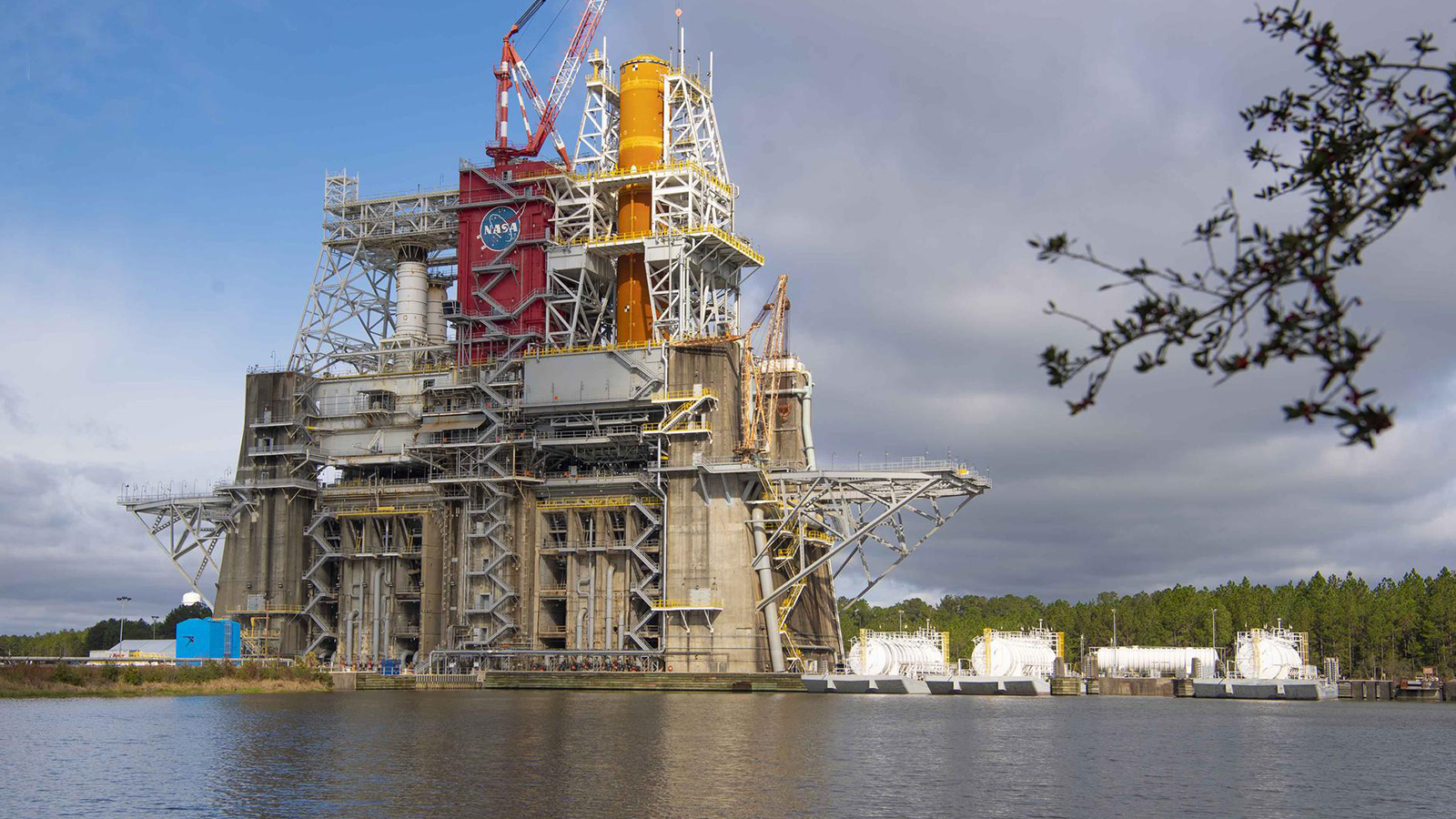Stay Up to Date
Submit your email address to receive the latest industry and Aerospace America news.
At stake in Saturday’s Space Launch System “hot fire” is feasibility of a crewless launch this year
For almost a year, a core stage of a Space Launch System rocket has been anchored to the B-2 test stand at NASA’s Stennis Center in Mississippi while engineers from NASA and Boeing ran tests that included simulating the aerodynamic forces of launch and powering up the flight control software to build confidence that SLS can safely send astronauts to orbit under the Artemis moon program.
On Saturday comes one final hurdle, a hot fire test, in which engineers will ignite the core stage’s four RS-25 engines, the same kind that powered the space shuttle orbiters. The engines, built by Aerojet Rocketdyne, must burn for 8 minutes, meant to simulate the first minutes of flight when an SLS would propel astronauts and an Orion crew capsule to orbit.
The hot fire is the last in a series of tests that NASA and Boeing have been conducting since January of last year, collectively referred to as the Green Run because it is the first time engineers have powered up various hardware and flight control software of the SLS core stage design.
NASA plans to conduct the first SLS launch, an uncrewed flight with an Orion capsule dubbed Artemis-1, by the end of 2021, about four years behind the original schedule. The Green Run tests, originally scheduled to conclude in 2020, have also been delayed a handful of times when spiking covid-19 cases and approaching hurricanes and tropical storms prompted Stennis to close.
Boeing and NASA also have proceeded cautiously in part to minimize risk of damaging the core stage, because it’s the same one that will propel the inaugural flight later this year, after the stage and its four engines are cleaned and refurbished. This core is not “a developmental or test article,” Boeing SLS Program Manager John Shannon noted to reporters on Jan. 12.
“We’ll just take the time required to make sure we are treating this flight article appropriately and in continuing to march forward,” Shannon said. “We’re heading into [the hot fire] with a mindset of we are learning, and if we need to stop and regroup and then press forward, we will absolutely do that.”
NASA will begin its hot fire broadcast at 3:20 p.m. Central U.S. time. The two-hour test window opens at 4 p.m. local time.
Early Saturday, Boeing and NASA technicians will pump about 700,000 gallons of liquid hydrogen and liquid oxygen into the propellant tanks of the core stage, a process that takes approximately 4 hours. Ground controllers will then start the countdown sequence, halting at T-10, when the Green Run test conductor will make the final decision whether to proceed. About 6 seconds before T-0, the RS-25 engines will ignite.
Throughout the 485-second run, the SLS flight computers will periodically command the engine nozzles to gimbal, or swing from side to side, as they would to adjust the trajectory of an SLS in flight.
The flight software must automatically shut the engines off after 485 seconds, but Shannon said flight controllers could manually halt the test if needed. In that scenario, the hot fire might still be deemed successful.
“We’ll have really all the engineering data we need to gather after about 250 seconds of that firing,” he said.
If all goes as planned, NASA and Boeing will spend the subsequent several days analyzing the data and inspecting the stage. The core stage and its engines will be loaded onto a barge and shipped to NASA’s Kennedy Space Center in mid-February. Over the coming months the core stage will be joined with the rest of the SLS launch vehicle, consisting of two five-segment Northrop Grumman solid rocket boosters and an upper stage built by United Launch Alliance, and topped with an Orion crew capsule for the crewless Artemis-1 launch.
Beyond any technical difficulties, the upcoming change in administration poses potential delays for that mission and any future SLS flights, said Casey Dreier, a policy analyst at The Planetary Society in California, which advocates for space exploration.
President-elect Joe Biden and members of his transition team have not disclosed their plans for NASA or the Artemis program’s goal to return U.S. astronauts to the moon by the end of 2024, a signature initiative of President Donald Trump and Vice President Mike Pence. But if an SLS rocket is indeed ready to fly this year, Dreier thinks there’s a good chance the Biden administration would decide to proceed with the uncrewed inaugural flight.
“What else do you do with an SLS, frankly?” he said.
About cat hofacker
Cat helps guide our coverage and keeps production of the print magazine on schedule. She became associate editor in 2021 after two years as our staff reporter. Cat joined us in 2019 after covering the 2018 congressional midterm elections as an intern for USA Today.
Related Posts
Stay Up to Date
Submit your email address to receive the latest industry and Aerospace America news.




